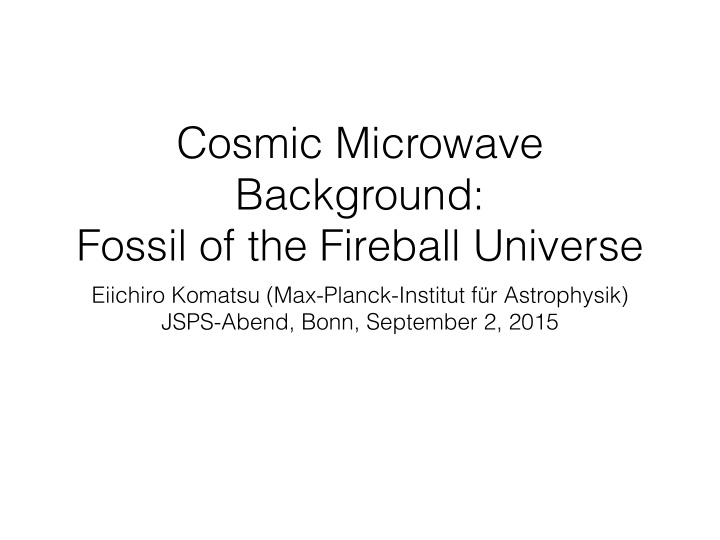



Cosmic Microwave Background: Fossil of the Fireball Universe Eiichiro Komatsu (Max-Planck-Institut für Astrophysik) JSPS-Abend, Bonn, September 2, 2015
Seeing the Early Universe • Astronomers often talk about the early Universe as if they were there to see it… • The stories told by astronomers are remarkable, but aren’t they just imaginations of astronomers? • Although we cannot be there physically, we can observe the phenomena in the early Universe using powerful telescopes • We are not making stuff up!
Seeing the Early Universe • The goal of my presentation is to show you how we are seeing and studying the early Universe directly using the light from the epoch of the fireball Universe • For the next 15 minutes, you will be hearing the well- established results from a series of observations and measurements made over the last half century • So, please sit back and enjoy learning about what it is like to see the early Universe
Fireball Universe Time Hot and Dense Space
Fireball Universe Time Hot and Dense Hot Expansion Space
Fireball Universe Time Hot and Dense Cooled Hot down Expansion Expansion Space
Definitive Result • Those photons which filled the fireball Universe are still with us • There are 410 such photons per cubic centimetre • Due to the expansion of space and cooling down, these photons are cold, and their wavelength is in the radio/microwave region
Dr. Hiranya Peiris ( University College London ) All you need to do is to detect radio waves. For example, 1% of noise on the TV is from the fireball Universe
Sky in the visible light [~500nm]
Sky in the microwaves [~1mm]
Sky in the microwaves [~1mm] Light from the fireball Universe filling our sky The Cosmic Microwave Background (CMB)
Temperature of CMB –270.5°C 2.7K in absolute temperature
1965
The real detector system used by Penzias & Wilson The 3rd floor of Deutsches Museum Donated by Dr. Penzias, Arno Penzias who was born in Munich
4K Planck Spectrum 2.725K Planck Spectrum 2K Planck Spectrum Rocket (COBRA) Satellite (COBE/FIRAS) Brightness Rotational Excitation of CN Ground-based Balloon-borne Satellite (COBE/DMR) Spectrum of CMB = Planck Spectrum 3m 30cm 3mm 0.3mm Wavelength
Fireball Universe, Observed • The Planck spectrum is achieved only when matter and radiation are exchanging energies frequently • Called “thermal equilibrium” • Imagine a blast furnace (Hochofen) Max Planck (1858-1947) • Today’s Universe is not in thermal equilibrium (we die otherwise), which means that the Universe was in thermal equilibrium in the past - fireball Universe [Urknalls]
Origin of CMB • When matter and radiation were hotter than 3000 K, matter was completely ionised. The Universe was filled with plasma, which behaves just like a soup • The main ingredients of this soup include: • Photons, Protons, electrons, and helium nuclei
Helium Nuclei Protons Electrons Photons
Time 380,000 years (temperature is 3000K) 23
2001
WMAP Science Team July 19, 2002 • WMAP was launched on June 30, 2001 • The WMAP mission ended after 9 years of operation
WMAP Spacecraft Spacecraft WMAP No cryogenic components upper omni antenna back to back line of sight Gregorian optics, 1.4 x 1.6 m primaries 60K passive thermal radiator focal plane assembly feed horns secondary reflectors 90K thermally isolated instrument cylinder 300K warm spacecraft with: medium gain antennae - instrument electronics - attitude control/propulsion - command/data handling deployed solar array w/ web shielding - battery and power control MAP990422
Outstanding Questions • Where does anisotropy in CMB temperature come from? • This is the origin of galaxies, stars, planets, and everything else we see around us, including ourselves • The leading idea: quantum fluctuations in vacuum, stretched to cosmological length scales by a rapid exponential expansion of the universe called “ cosmic inflation ” in the very early universe
Our Origin • WMAP taught us that galaxies, stars, planets, and ourselves originated from tiny fluctuations in the early Universe
Kosmische Miso Suppe • When matter and radiation were hotter than 3000 K, matter was completely ionised. The Universe was filled with plasma, which behaves just like a soup • Think about a Miso soup (if you know what it is). Imagine throwing Tofus into a Miso soup, while changing the density of Miso • And imagine watching how rippes are created and propagate throughout the soup
Outstanding Questions • Where does anisotropy in CMB temperature come from? • This is the origin of galaxies, stars, planets, and everything else we see around us, including ourselves • The leading idea: quantum fluctuations in vacuum, stretched to cosmological length scales by a rapid exponential expansion of the universe called “ cosmic inflation ” in the very early universe
Data Analysis • Decompose temperature fluctuations in the sky into a set of waves with various wavelengths • Make a diagram showing the strength of each wavelength
Amplitude of Waves [ μ K 2 ] Long Wavelength Short Wavelength 180 degrees/(angle in the sky)
Cosmic Pie Chart • WMAP determined the abundance of various components in the Universe • As a result, we came to realise that we do not understand 95% of our Universe… H&He Dunkle Materie Dunkle Energie
Current Question: Origin of Fluctuations • Who dropped those Tofus into the cosmic Miso soup?
Summary • We are seeing physical conditions of the early Universe using CMB • Our origin goes back to tiny fluctuations that existed in the early Universe • Origin of fluctuations? • To understand the origin of fluctuations? We are trying to launch another CMB satellite with colleagues in Japan: LiteBIRD
JAXA ESA + possibly NASA 2025– [proposed] LiteBIRD 2022– [proposed]
Recommend
More recommend